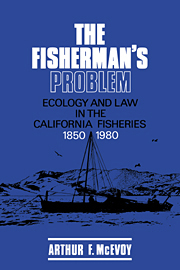Book contents
- Frontmatter
- Contents
- List of figures
- List of tables
- Preface
- Acknowledgments
- List of abbreviations
- Introduction
- I The miner's canary
- 2 Aboriginal fishery management
- 3 The Indian fisheries commercialized
- II Sun, wind, and sail, 1850–1910
- III The industrial frontier, 1910–1950
- IV Enclosure of the ocean, 1950–1980
- Conclusion
- Appendixes
- Notes
- Selected bibliography
- Index
2 - Aboriginal fishery management
Published online by Cambridge University Press: 06 January 2010
- Frontmatter
- Contents
- List of figures
- List of tables
- Preface
- Acknowledgments
- List of abbreviations
- Introduction
- I The miner's canary
- 2 Aboriginal fishery management
- 3 The Indian fisheries commercialized
- II Sun, wind, and sail, 1850–1910
- III The industrial frontier, 1910–1950
- IV Enclosure of the ocean, 1950–1980
- Conclusion
- Appendixes
- Notes
- Selected bibliography
- Index
Summary
Everything in the world talks, just as we are now – the trees, rocks, everything. But we cannot understand them, just as the white people do not understand Indians.
– Nomlaki informantBefore the European and Asian in-migrations of the nineteenth century, some 310,000 American Indians lived in what is now the State of California (Figure 2.1). So fertile were the habitats from which they hunted, gathered, and fished their subsistence that human beings populated the earth more densely here than anywhere on the continent north of central Mexico. Urban populations in aboriginal Mesoamerica grew as dense as they did by developing intensive agriculture and by taxing the resources of outlying, subjugated peoples, but in California each Indian community depended primarily on the particular combination of wild plants and animals available within its own locality. California's extreme ecological diversity thus encouraged the development of one of the most culturally variegated human populations the world has ever seen. Some of the most populous, materially wealthy, and culturally elaborate California Indian communities were those that harvested fisheries that supported commercial enterprise at a later time.
The history of the California fisheries thus began some 4,000 years before the Spanish friars arrived. Aboriginal groups faced the problem of environment no less squarely than their technologically more advanced successors did. Despite their relatively small numbers and simple techniques, Indian hunting and gathering economies apparently could strain their resources enough to damage them.
- Type
- Chapter
- Information
- The Fisherman's ProblemEcology and Law in the California Fisheries, 1850–1980, pp. 19 - 40Publisher: Cambridge University PressPrint publication year: 1986
- 1
- Cited by

